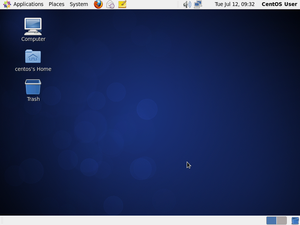| LinuxPlace.net the Linux Place on the Net |
CentOS
By Wikipedia, the free encyclopedia
http://en.wikipedia.org/wiki/CentOS
CentOS is a free operating system based on Red Hat Enterprise Linux (RHEL). It exists to provide a free enterprise class computing platform and strives to maintain 100% binary compatibility with its upstream distribution. CentOS stands for Community ENTerprise Operating System.
CentOS is the most popular Linux distribution for web servers with almost 30% of all Linux web servers using it.
Structure
Red Hat Enterprise Linux is available only through a paid subscription service that provides access to software updates and varying levels of technical support. The product is largely composed of software packages distributed under either an open source or a free software license and the source code for these packages is made public by Red Hat.
CentOS developers use Red Hat's source code to create a final product very similar to Red Hat Enterprise Linux. Red Hat's branding and logos are changed because Red Hat does not allow them to be redistributed.
CentOS is available free of charge. Technical support is primarily provided by the community via official mailing lists, web forums, and chat rooms. The project is not affiliated with Red Hat and thus receives no financial or logistical support from the company; instead, the CentOS Project relies on donations from users and organizational sponsors.
Versioning scheme
CentOS version numbers have two parts, a major version and a minor version. The major and minor version numbers respectively correspond to the major version and update set of Red Hat Enterprise Linux from which the source packages used to build CentOS are taken. For example, CentOS 4.4 is built from the source packages from Red Hat Enterprise Linux 4 update 4.
Since mid-2006, starting with version 4.4 (formally known as Red Hat Enterprise Linux 4.0 update 4), Red Hat has adopted a versioning convention identical to that of CentOS, e.g., Red Hat Enterprise Linux 4.5.
Release history
The architecture information is taken from the CentOS Overview page.
| CentOS Release | Full Updates | Maintenance Updates |
|---|---|---|
| 3 | 2006-07-20 | 2010-10-31 |
| 4 | 2009-03-31 | 2012-02-29 |
| 5 | Q4 2011 | 2014-03-31 |
| 6 | Q4 2014 | 2017-11-30 |
Architectures
CentOS supports only the x86 architectures:
- x86 (32-bit)
- x86-64 (AMD's AMD64 and Intel's EM64T, 64-bit)
The following architectures are not supported by CentOS (as of version 5):
- IA-64 (Intel Itanium architecture, 64-bit) (beta support since CentOS 3)
- PowerPC/32 (Apple Macintosh and PowerMac running the G3 or G4 PowerPC processor) (beta support since CentOS 3)
- IBM Mainframe (eServer zSeries and S/390) (not CentOS 5)
- Alpha (CentOS 4 only)
- SPARC (beta support since CentOS 3)
Bootable media version
A Live CD version of CentOS is available at mirror.centos.org.
A Live USB of CentOS can be created manually or with UNetbootin.
Tao Linux
Tao Linux was another prominent distribution derived from Red Hat Enterprise Linux. Its primary developer announced in June 2006 that Tao would be retired and rolled into CentOS development. Tao users migrated to the CentOS release via "yum update".
History and organizational difficulties
In July 2009, it was reported that CentOS's founder, Lance Davis, had disappeared in 2008. Davis had ceased contribution to the project but continued to hold the registration for the CentOS domain and PayPal account. In August 2009, the CentOS team reportedly made contact with Davis and obtained the centos.info and centos.org domains.
Source: http://en.wikipedia.org/wiki/CentOS
Published - November 2011
Read all articles at the Linux Place!
All rights reserved © 2011-2024 LinuxPlace.net
